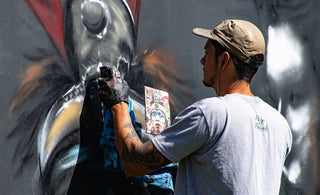
If you walk through the streets of your local city, you’re bound to come across a variety of different types of street art, from graffiti and tags to large-scale murals. But what exactly are street art and graffiti?
Are they the same art form - is graffiti considered street art? Read on to learn more about the world of street art/ graffiti art. In this blog, we’ll be exploring the history of street art and the differences between street art and graffiti art.
What is Street Art?
Street art refers to any artwork created on the streets - whether it be on the pavement, the sides of disused buildings or even on subway trains. This medium of art can’t be pinned down to a certain style - it can include a wide range of artistic styles and art forms.
Street art can include methods such as fly posting, stencilling, tagging, and drawing. Street art can be found in all major cities - whether you’re in London, Liverpool or Leeds, you’re sure to come across several different styles of street art.
Check out this blog to find out some of the best places to find street art in London. Murals are a popular form of public art. Murals are large-scale pieces of art found in urban areas, and can often span across entire buildings or walls.
Although there are still laws on graffiti and urban art, many artists are invited to paint in public places. However, more and more urban areas are being gentrified; which means that urban art is being destroyed or painted over.
What About Street Artists?
In 2024, there are more street artists than ever. When you think of street art, chances are, you automatically think of Banksy. Contemporary street artist/ graffiti artist Banksy is arguably the most famous street artist alive today in the art world.
Known for his political and social themes, Banksy’s identity remains anonymous - creating an air of mystery around his work. As famous street artists (like Banksy) grow their reputation, they often begin selling art prints. Their work may end up framed in art galleries.
For example, Stony’s work has been exhibited around the world, from The Louvre in Paris to New York and Dubai. Stony signed with the UK Publishing House, DeMontfort Fine Art in 2016.
His expressive urban art depicted art and emotion in its rawest form, painting his life on a canvas. You can invest in art from the likes of Stony and Banksy at Grove Gallery.
The History of Street Art
Street art has drastically changed the contemporary art scene. People may look at street art and assume it’s a modern creation; however, you may be surprised that the concept of urban art has been around for as long as streets have existed. Graffiti and street art are not inventions of the 20th century.
Ancient Street Art
One of the earliest pieces of ‘urban art’ that has been identified was found in an Argentinian cave - and dates back to around 7000 BC. Known as Cueva de las Manos, this painting was thought to be created for religious or ceremonial purposes.
In fact, many cave paintings found around this time period were often ceremonial or religious, but unfortunately, we don’t know much about the meaning behind these paintings. This form of art was also prominent in ancient Europe - you could find urban art on the streets of Ancient Greece and Ancient Rome - some of which can still be viewed to this day.
You could find street art in Pompeii with a range of images depicting sex, religion and politics. Some urban art of the time would also advertise services - for example, a piece of wall art in the ancient Greek city of Ephesus appeared to advertise a local brothel, depicting a foot, a hand and a number. Religion was a huge subject of street art in Ancient Europe.
For example, a mural in Rome (dated around 200 AD) depicted Jesus. Some would be in favour of religion, but others would mock religion, highlighting the public opinion of the time. Street art has been used as a form of expression and protest for thousands of years.
Modern Street Art
Let’s jump ahead to the world of modern street art. The invention of the spray can kickstarted modern street art in the early 1900s. When Edward Seymour invented the spray paint can in 1949, urban art quickly followed.
Street artists began using spray paint to paint art in public spaces as it was much easier than using a paintbrush. With spray paint cans, street artists and graffiti artists were able to create larger works of art with much less effort.
In the late 90s and early 00s, a huge societal shift happened in regard to street art. More and more people began to see street art as art instead of vandalism or criminal damage, and communities began to embrace urban art in their streets.
Is Street Art The Same as Graffiti?
Many people use the terms ‘street art’ and ‘graffiti’ interchangeably - however, not all street art can be defined as graffiti. Graffiti is simply a form of street art. Typically, graffiti is letter or word-based, whereas murals and other forms of urban art are image-based.
Graffiti artists will often paint their graffiti ‘tags’ - their signature that allows any viewers to identify their art. Graffiti art and street art are both found in urban areas and often, both forms of art will overlap. Some graffiti artists will create artwork that includes both images and graffiti writing, whereas other graffiti artists/ graffiti writers will only use words in their art.
The term ‘graffiti’ derives from the Greek term ‘graphein’, which means to scratch, draw or write. The history of graffiti art is as long as art itself. You may be familiar with the term ‘graffiti culture’. This refers to graffiti artists who create a statement through their art.
Typically, this form of artwork doesn’t seek public approval - instead, the intention is to get a certain message across. This is why you often find graffiti in times of political or societal unrest.
For example, graffiti with messages such as ‘ban the vaccine’ appeared in urban areas following the Covid-19 pandemic.






